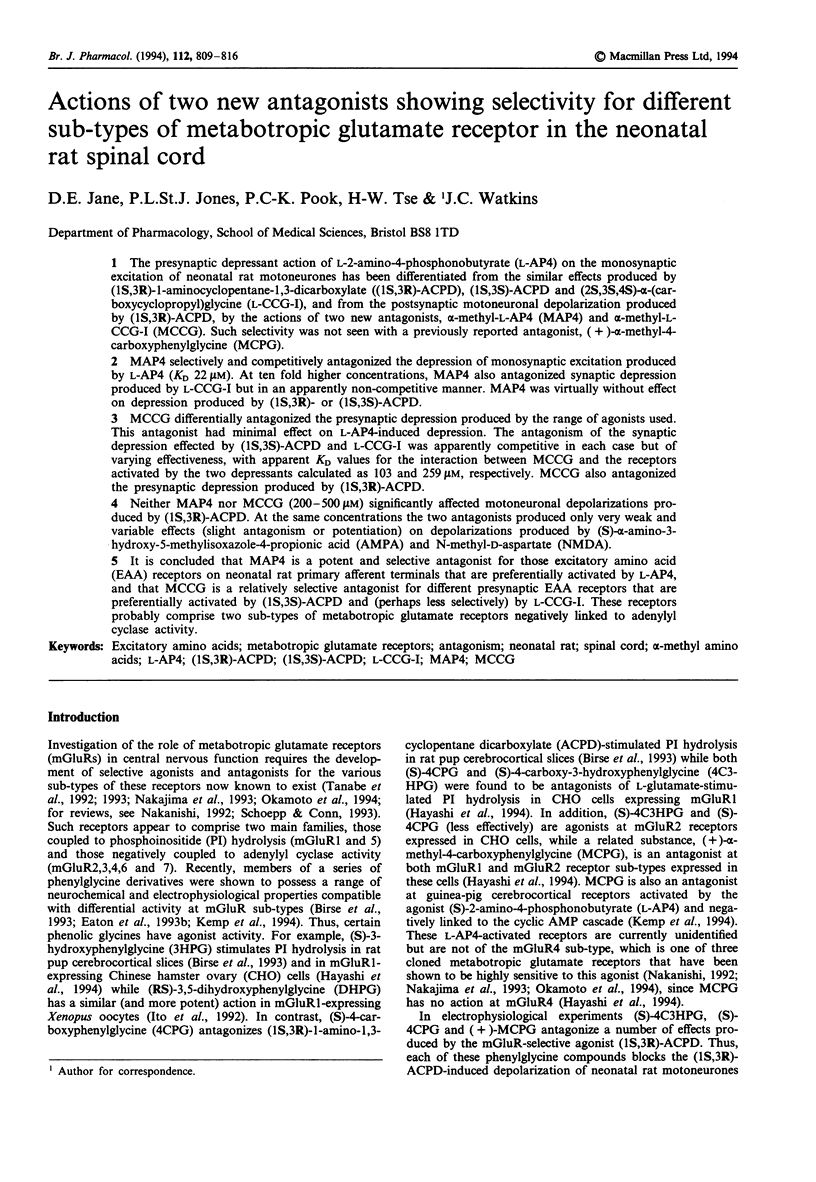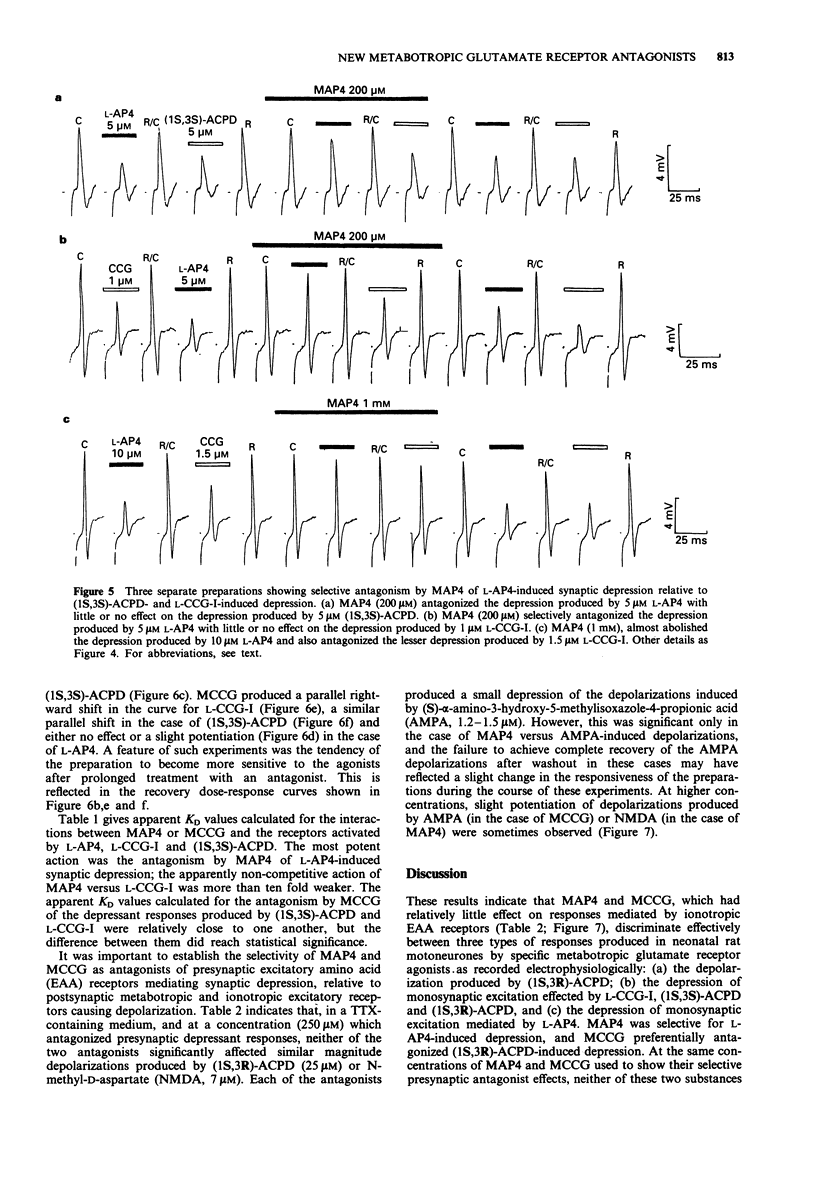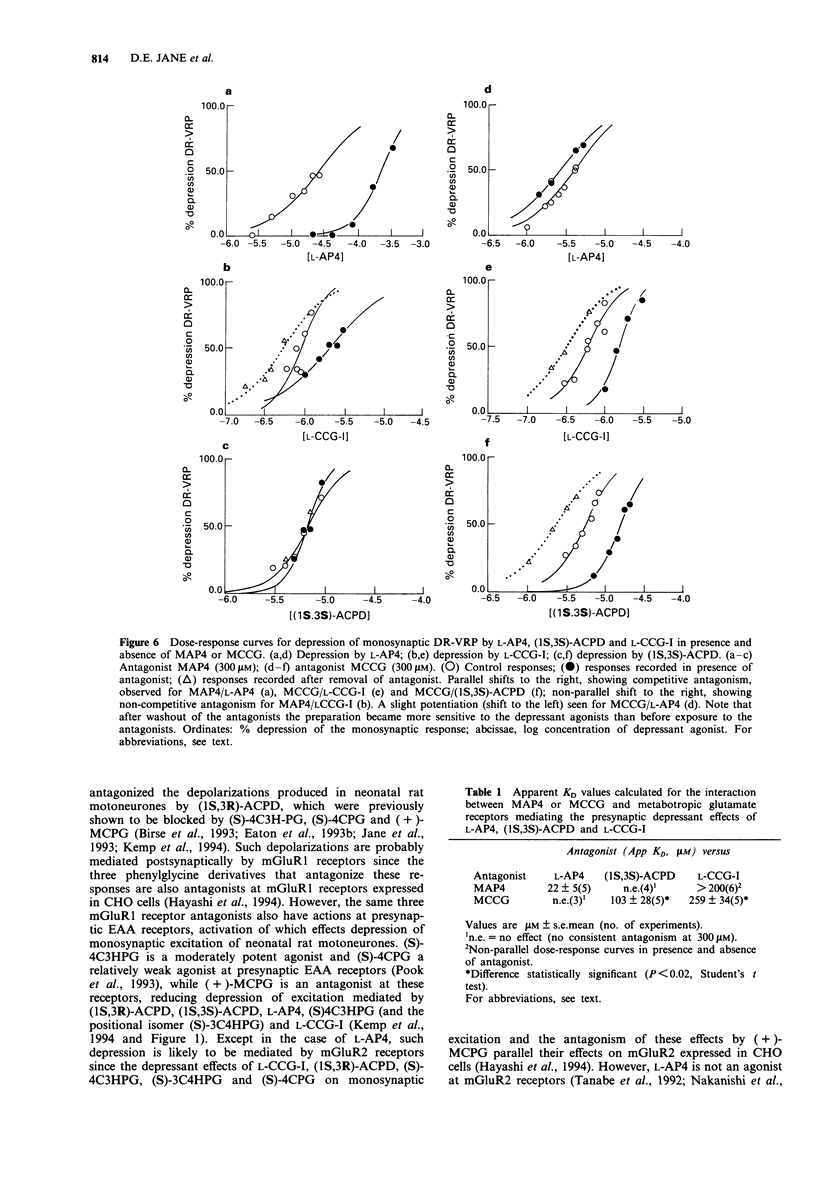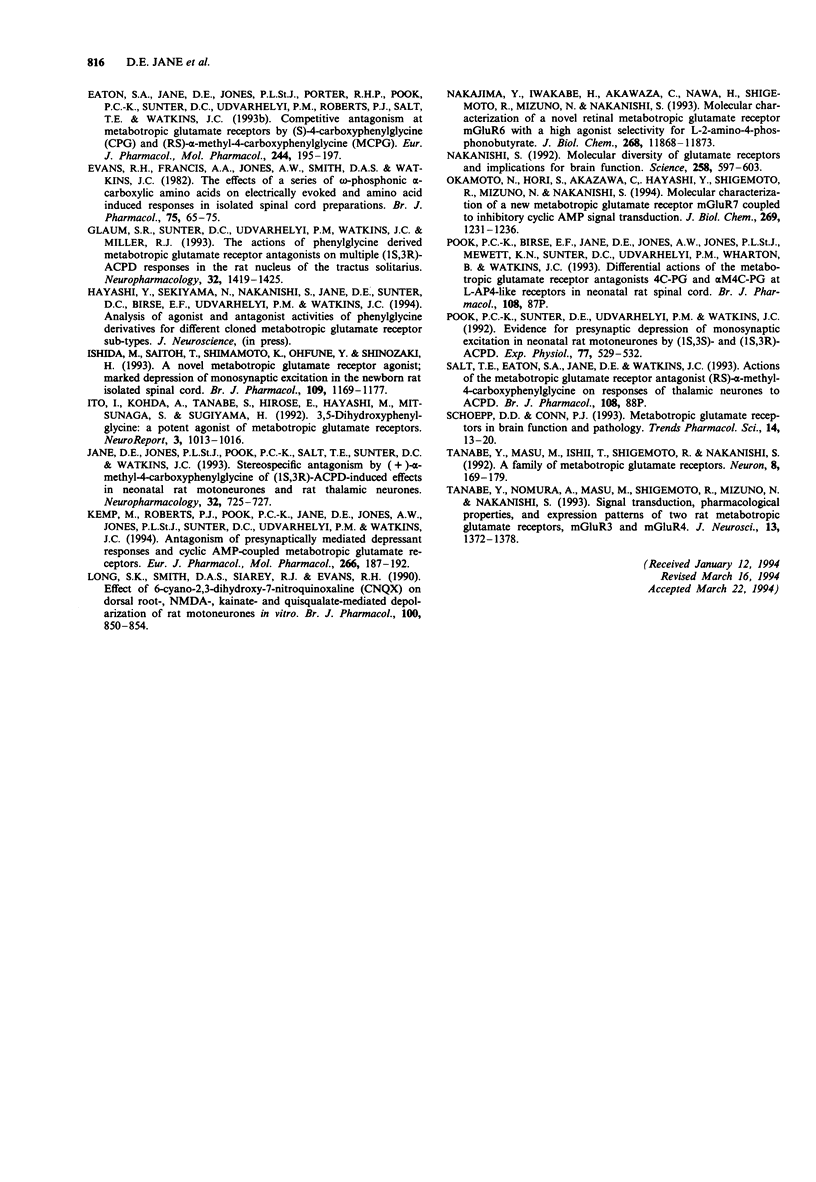Abstract
1. The presynaptic depressant action of L-2-amino-4-phosphonobutyrate (L-AP4) on the monosynaptic excitation of neonatal rat motoneurones has been differentiated from the similar effects produced by (1S,3R)-1-aminocyclopentane-1,3-dicarboxylate ((1S,3R)-ACPD), (1S,3S)-ACPD and (2S,3S,4S)-alpha-(carboxycyclopropyl)glycine (L-CCG-I), and from the postsynaptic motoneuronal depolarization produced by (1S,3R)-ACPD, by the actions of two new antagonists, alpha-methyl-L-AP4 (MAP4) and alpha-methyl-L-CCG-I (MCCG). Such selectivity was not seen with a previously reported antagonist, (+)-alpha-methyl-4-carboxyphenylglycine (MCPG). 2. MAP4 selectively and competitively antagonized the depression of monosynaptic excitation produced by L-AP4 (KD 22 microM). At ten fold higher concentrations, MAP4 also antagonized synaptic depression produced by L-CCG-I but in an apparently non-competitive manner. MAP4 was virtually without effect on depression produced by (1S,3R)- or (1S,3S)-ACPD. 3. MCCG differentially antagonized the presynaptic depression produced by the range of agonists used. This antagonist had minimal effect on L-AP4-induced depression. The antagonism of the synaptic depression effected by (1S,3S)-ACPD and L-CCG-I was apparently competitive in each case but of varying effectiveness, with apparent KD values for the interaction between MCCG and the receptors activated by the two depressants calculated as 103 and 259 microM, respectively. MCCG also antagonized the presynaptic depression produced by (1S,3R)-ACPD. 4. Neither MAP4 nor MCCG (200-500 microM) significantly affected motoneuronal depolarizations produced by (1S,3R)-ACPD.(ABSTRACT TRUNCATED AT 250 WORDS)
Full text
PDF







Selected References
These references are in PubMed. This may not be the complete list of references from this article.
- Bashir Z. I., Bortolotto Z. A., Davies C. H., Berretta N., Irving A. J., Seal A. J., Henley J. M., Jane D. E., Watkins J. C., Collingridge G. L. Induction of LTP in the hippocampus needs synaptic activation of glutamate metabotropic receptors. Nature. 1993 May 27;363(6427):347–350. doi: 10.1038/363347a0. [DOI] [PubMed] [Google Scholar]
- Birse E. F., Eaton S. A., Jane D. E., Jones P. L., Porter R. H., Pook P. C., Sunter D. C., Udvarhelyi P. M., Wharton B., Roberts P. J. Phenylglycine derivatives as new pharmacological tools for investigating the role of metabotropic glutamate receptors in the central nervous system. Neuroscience. 1993 Feb;52(3):481–488. doi: 10.1016/0306-4522(93)90400-a. [DOI] [PubMed] [Google Scholar]
- Eaton S. A., Birse E. F., Wharton B., Sunter D. C., Udvarhelyi P. M., Watkins J. C., Salt T. E. Mediation of thalamic sensory responses in vivo by ACPD-activated excitatory amino acid receptors. Eur J Neurosci. 1993 Feb 1;5(2):186–189. doi: 10.1111/j.1460-9568.1993.tb00484.x. [DOI] [PubMed] [Google Scholar]
- Eaton S. A., Jane D. E., Jones P. L., Porter R. H., Pook P. C., Sunter D. C., Udvarhelyi P. M., Roberts P. J., Salt T. E., Watkins J. C. Competitive antagonism at metabotropic glutamate receptors by (S)-4-carboxyphenylglycine and (RS)-alpha-methyl-4-carboxyphenylglycine. Eur J Pharmacol. 1993 Jan 15;244(2):195–197. doi: 10.1016/0922-4106(93)90028-8. [DOI] [PubMed] [Google Scholar]
- Evans R. H., Francis A. A., Jones A. W., Smith D. A., Watkins J. C. The effects of a series of omega-phosphonic alpha-carboxylic amino acids on electrically evoked and excitant amino acid-induced responses in isolated spinal cord preparations. Br J Pharmacol. 1982 Jan;75(1):65–75. doi: 10.1111/j.1476-5381.1982.tb08758.x. [DOI] [PMC free article] [PubMed] [Google Scholar]
- Glaum S. R., Sunter D. C., Udvarhelyi P. M., Watkins J. C., Miller R. J. The actions of phenylglycine derived metabotropic glutamate receptor antagonists on multiple (1S,3R)-ACPD responses in the rat nucleus of the tractus solitarius. Neuropharmacology. 1993 Dec;32(12):1419–1425. doi: 10.1016/0028-3908(93)90039-6. [DOI] [PubMed] [Google Scholar]
- Ishida M., Saitoh T., Shimamoto K., Ohfune Y., Shinozaki H. A novel metabotropic glutamate receptor agonist: marked depression of monosynaptic excitation in the newborn rat isolated spinal cord. Br J Pharmacol. 1993 Aug;109(4):1169–1177. doi: 10.1111/j.1476-5381.1993.tb13745.x. [DOI] [PMC free article] [PubMed] [Google Scholar]
- Ito I., Kohda A., Tanabe S., Hirose E., Hayashi M., Mitsunaga S., Sugiyama H. 3,5-Dihydroxyphenyl-glycine: a potent agonist of metabotropic glutamate receptors. Neuroreport. 1992 Nov;3(11):1013–1016. [PubMed] [Google Scholar]
- Jane D. E., Jones P. L., Pook P. C., Salt T. E., Sunter D. C., Watkins J. C. Stereospecific antagonism by (+)-alpha-methyl-4-carboxyphenylglycine (MCPG) of (1S,3R)-ACPD-induced effects in neonatal rat motoneurones and rat thalamic neurones. Neuropharmacology. 1993 Jul;32(7):725–727. doi: 10.1016/0028-3908(93)90088-k. [DOI] [PubMed] [Google Scholar]
- Kemp M., Roberts P., Pook P., Jane D., Jones A., Jones P., Sunter D., Udvarhelyi P., Watkins J. Antagonism of presynaptically mediated depressant responses and cyclic AMP-coupled metabotropic glutamate receptors. Eur J Pharmacol. 1994 Jan 15;266(2):187–192. doi: 10.1016/0922-4106(94)90109-0. [DOI] [PubMed] [Google Scholar]
- Long S. K., Smith D. A., Siarey R. J., Evans R. H. Effect of 6-cyano-2,3-dihydroxy-7-nitro-quinoxaline (CNQX) on dorsal root-, NMDA-, kainate- and quisqualate-mediated depolarization of rat motoneurones in vitro. Br J Pharmacol. 1990 Aug;100(4):850–854. doi: 10.1111/j.1476-5381.1990.tb14103.x. [DOI] [PMC free article] [PubMed] [Google Scholar]
- Nakajima Y., Iwakabe H., Akazawa C., Nawa H., Shigemoto R., Mizuno N., Nakanishi S. Molecular characterization of a novel retinal metabotropic glutamate receptor mGluR6 with a high agonist selectivity for L-2-amino-4-phosphonobutyrate. J Biol Chem. 1993 Jun 5;268(16):11868–11873. [PubMed] [Google Scholar]
- Nakanishi S. Molecular diversity of glutamate receptors and implications for brain function. Science. 1992 Oct 23;258(5082):597–603. doi: 10.1126/science.1329206. [DOI] [PubMed] [Google Scholar]
- Okamoto N., Hori S., Akazawa C., Hayashi Y., Shigemoto R., Mizuno N., Nakanishi S. Molecular characterization of a new metabotropic glutamate receptor mGluR7 coupled to inhibitory cyclic AMP signal transduction. J Biol Chem. 1994 Jan 14;269(2):1231–1236. [PubMed] [Google Scholar]
- Pook P. C., Sunter D. C., Udvarhelyi P. M., Watkins J. C. Evidence for presynaptic depression of monosynaptic excitation in neonatal rat motoneurones by (1S,3S)- and (1S,3R)-ACPD. Exp Physiol. 1992 May;77(3):529–532. doi: 10.1113/expphysiol.1992.sp003617. [DOI] [PubMed] [Google Scholar]
- Schoepp D. D., Conn P. J. Metabotropic glutamate receptors in brain function and pathology. Trends Pharmacol Sci. 1993 Jan;14(1):13–20. doi: 10.1016/0165-6147(93)90107-u. [DOI] [PubMed] [Google Scholar]
- Tanabe Y., Masu M., Ishii T., Shigemoto R., Nakanishi S. A family of metabotropic glutamate receptors. Neuron. 1992 Jan;8(1):169–179. doi: 10.1016/0896-6273(92)90118-w. [DOI] [PubMed] [Google Scholar]
- Tanabe Y., Nomura A., Masu M., Shigemoto R., Mizuno N., Nakanishi S. Signal transduction, pharmacological properties, and expression patterns of two rat metabotropic glutamate receptors, mGluR3 and mGluR4. J Neurosci. 1993 Apr;13(4):1372–1378. doi: 10.1523/JNEUROSCI.13-04-01372.1993. [DOI] [PMC free article] [PubMed] [Google Scholar]


